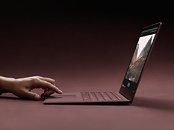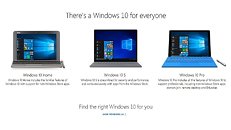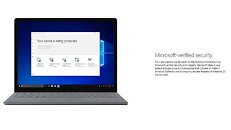Wednesday, May 3rd 2017

Meet Microsoft's New Take on Windows: The Windows 10 S
The "RT" ghost is still alive in people's minds, as is particularly fluent on people's tongues whenever someone brings up Microsoft's new Windows 10 S OS. The one that limits the scope and variety of applications you can run on your own system. That forces you to go through Windows' still lackluster Store (sorry, but I've never seen such bad flow, bugs and hiccups on an app as I do in that one.)
It's only right, really - the reduced compatibility and walled-garden approach is there still, even if this one OS now isn't limited to ARM - or to x86, for that matter. This new approach now allows both UWP apps and Win32 apps which have been ported using Desktop Bridge from the store to work. However, expect Win32 apps with a native, non-ported installer to fail. Not all is bad, though: Windows has an amazing backlog for legacy hardware, software and applications, but that same legacy means it's more opened up to security vulnerabilities, and even applications which can wreak havoc on the system with excessive permissions, and unpatched issues.The goal here, Microsoft states, is to offer a more closed-off environment for those clients that need it, limiting the amount of applications that can run on hardware equipped with its newest OS. And there truly is need, and use cases, for such an environment. Businesses will likely start using this one version of Windows, looking towards a more uniform and consistent experience and further lock-down its devices. Public services, on the other hand, which usually brew their own applications or pay specialized companies to design them, won't have much use for such an OS.
UWP apps and ported Win32 apps offer more predictable, streamlined and tested behavior, which would likely mean more consistent performance, better battery life, and improved security. The main target segment of the new Windows 10 version, however, is the education market, which has been dominated by Chromebooks. In order to bypass the limitation, a $50 upgrade can be purchased to get Windows 10 Pro, so at least there is some way to abandon the garden. Though this is an interesting product that will certainly cater to some particular use cases, I'd say it's certain that none of our good readers will be looking towards this Windows 10 implementation.
For that matter, it's also not restricted to x86 laptops, and it would make sense to see Windows 10 S available on ARM based PCs coming later this year.
Sources:
ETeknix, AnandTech
It's only right, really - the reduced compatibility and walled-garden approach is there still, even if this one OS now isn't limited to ARM - or to x86, for that matter. This new approach now allows both UWP apps and Win32 apps which have been ported using Desktop Bridge from the store to work. However, expect Win32 apps with a native, non-ported installer to fail. Not all is bad, though: Windows has an amazing backlog for legacy hardware, software and applications, but that same legacy means it's more opened up to security vulnerabilities, and even applications which can wreak havoc on the system with excessive permissions, and unpatched issues.The goal here, Microsoft states, is to offer a more closed-off environment for those clients that need it, limiting the amount of applications that can run on hardware equipped with its newest OS. And there truly is need, and use cases, for such an environment. Businesses will likely start using this one version of Windows, looking towards a more uniform and consistent experience and further lock-down its devices. Public services, on the other hand, which usually brew their own applications or pay specialized companies to design them, won't have much use for such an OS.
UWP apps and ported Win32 apps offer more predictable, streamlined and tested behavior, which would likely mean more consistent performance, better battery life, and improved security. The main target segment of the new Windows 10 version, however, is the education market, which has been dominated by Chromebooks. In order to bypass the limitation, a $50 upgrade can be purchased to get Windows 10 Pro, so at least there is some way to abandon the garden. Though this is an interesting product that will certainly cater to some particular use cases, I'd say it's certain that none of our good readers will be looking towards this Windows 10 implementation.
For that matter, it's also not restricted to x86 laptops, and it would make sense to see Windows 10 S available on ARM based PCs coming later this year.



13 Comments on Meet Microsoft's New Take on Windows: The Windows 10 S
The masses are dumb and the masses want dumb shit.
I thought Dell bought WYSE though, not Microsoft..
Goodarticle on why it's important.
Edit: What I don't agree at all with M$ is the fact that they are now selling Surface "Tabtops" with mediocre specs at premium prices with this limited OS. At my University the professors and a lot of my classmates use the older versions, and they are pretty cool IMO, but they are not limited from an OS which (for Computer Science students) is basically a social media OS, not a productivity one.